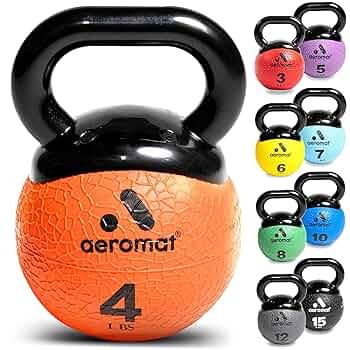Are you ready to level up your fitness game but confused about whether to reach for a kettlebell or a medicine ball? You’re not alone!
These two popular workout tools often leave fitness enthusiasts scratching their heads. Both offer unique benefits and can be pivotal in transforming your exercise routine. Understanding the difference between them is crucial to making the right choice for your fitness goals.
So, if you’re eager to maximize your workouts and make the most of your time in the gym, keep reading. We’ll dive into the essential differences, and by the end, you’ll know exactly which one is your perfect match.
Kettlebell Basics
Kettlebells and medicine balls are popular fitness tools. They help build strength and improve fitness.
Both tools look different and work in unique ways. Knowing their differences helps you choose the right one.
Design And Structure
A kettlebell is a cast-iron or steel weight with a handle on top. It looks like a ball with a grip.
A medicine ball is a round, weighted ball. It often has a soft or rubber surface and no handle.
- Kettlebell: solid metal, handle for swinging
- Medicine ball: soft or hard, no handle
- Kettlebells come in fixed weights
- Medicine balls vary in size and weight
Common Uses
Kettlebells are used for swinging, lifting, and dynamic moves. They improve strength and endurance.
Medicine balls are often thrown, caught, or used for core exercises. They help with power and coordination.
- Kettlebells: swings, squats, presses
- Medicine balls: throws, slams, twists
- Kettlebells focus on whole-body movement
- Medicine balls focus on explosive power
Benefits
Kettlebells build muscle, burn fat, and boost cardio fitness. They improve balance and grip strength.
Medicine balls increase power, help core strength, and improve hand-eye coordination. They also add variety.
- Kettlebells: strength, endurance, balance
- Medicine balls: power, core, coordination
- Both tools improve overall fitness
- Both can be used at home or gym
Medicine Ball Basics
A medicine ball is a weighted ball used for exercise. It helps improve strength and coordination.
People use medicine balls in many workouts. They can be thrown, caught, or lifted to build muscles.
Design And Structure
Medicine balls are round and come in different weights. They usually have a soft or rubbery surface.
The size is about the same as a soccer ball. This makes them easy to hold and throw.
- Weights range from 2 to 25 pounds
- Soft outer layer for grip and safety
- No handles or special shapes
Common Uses
Medicine balls are used in many types of workouts. They help with strength, speed, and balance.
Exercises include throwing, twisting, and lifting. They add resistance and increase workout intensity.
- Core training and abdominal exercises
- Partner tosses and reaction drills
- Functional fitness and rehabilitation
Benefits
Using a medicine ball improves muscle strength and coordination. It also helps with endurance.
Medicine ball workouts can be varied and fun. They engage many muscles at once for better fitness.
- Builds power and explosive strength
- Improves hand-eye coordination
- Enhances core stability and balance
Weight And Size Comparison
Kettlebells and medicine balls are popular fitness tools. They help build strength and improve fitness. Each has unique weights and sizes. Knowing these differences helps you choose the right one.
This comparison focuses on the typical weight ranges and sizes of kettlebells and medicine balls. Understanding these can guide your workout choices and space needs.
Kettlebell Weight And Size
Kettlebells have a fixed weight and a handle for swinging or lifting. They come in various weights, starting from light to very heavy. The size grows with the weight but stays compact.
- Weights usually start at 4 kg (9 lbs) and go up to 48 kg (106 lbs) or more.
- Heavier kettlebells have a larger diameter but similar shape.
- Compact size fits well in small spaces.
Medicine Ball Weight And Size
Medicine balls are round and do not have handles. Their size changes with weight. Lighter balls are smaller, heavier ones are larger. They are softer and easier to catch.
- Weights range from 1 kg (2 lbs) to 12 kg (26 lbs) or more.
- Size increases noticeably with heavier weights.
- Common sizes range from 8 inches to 14 inches in diameter.
Side-by-side Weight And Size Table
| Feature | Kettlebell | Medicine Ball |
|---|---|---|
| Weight Range | 4 kg to 48+ kg (9 lbs to 106+ lbs) | 1 kg to 12+ kg (2 lbs to 26+ lbs) |
| Size | Compact, grows slightly with weight | Varies greatly, larger with more weight |
| Shape | Bell with handle | Round ball |
| Use Space | Smaller footprint | Takes more space as weight increases |

Exercise Techniques
Kettlebells and medicine balls are popular fitness tools. They help build strength and improve fitness. Each tool works differently during exercises.
Understanding how to use kettlebells and medicine balls can improve your workout results. This guide explains exercise techniques for both tools.
Kettlebell Workouts
Kettlebell exercises use a handle and a weighted ball. They focus on swinging, lifting, and holding movements. This helps improve strength, balance, and endurance.
Common kettlebell moves include swings, goblet squats, and deadlifts. These exercises target multiple muscle groups. They require control and good form to avoid injury.
- Swings: Use hips to swing the kettlebell forward and back.
- Goblet Squats: Hold kettlebell close to chest while squatting.
- Deadlifts: Lift kettlebell from the ground with straight back.
- Turkish Get-Up: Move from lying to standing while holding kettlebell.
Medicine Ball Workouts
Medicine balls are weighted balls used for throwing, catching, and slamming exercises. They build power, coordination, and core strength.
These workouts often involve dynamic movements. Medicine ball exercises improve speed and agility by using explosive force.
- Slams: Lift ball overhead and slam it to the ground.
- Throws: Throw ball against a wall or to a partner.
- Russian Twists: Twist torso while holding ball to each side.
- Wall Balls: Squat and throw ball up to a target on the wall.
Muscle Groups Targeted
Kettlebells and medicine balls are popular workout tools. They help build strength and improve fitness.
Each tool targets different muscle groups. Knowing the differences can help you choose the right one.
Muscle Groups Targeted By Kettlebells
Kettlebell exercises mainly work the core, legs, and back. They use swinging and lifting motions.
These moves also strengthen the shoulders, arms, and hips. Kettlebells improve muscle endurance and power.
- Core muscles: abs and lower back
- Leg muscles: quads, hamstrings, glutes
- Back muscles: lats and traps
- Shoulders and arms: deltoids, biceps, triceps
- Hip muscles: hip flexors and extensors
Muscle Groups Targeted By Medicine Balls
Medicine balls focus on explosive power and coordination. They work the whole body with throwing and catching.
The main muscles worked are the core, chest, and arms. Medicine balls also help improve speed and agility.
- Core muscles: abs and obliques
- Chest muscles: pectorals
- Arm muscles: biceps and triceps
- Shoulders: deltoids
- Leg muscles: quads and calves (in some exercises)

Safety Tips And Precautions
Using kettlebells and medicine balls can improve your strength and fitness. It is important to follow safety rules to avoid injuries. Each tool has its own risks and precautions.
Knowing how to use kettlebells and medicine balls safely helps you get the best results. This guide shares tips to keep you safe while training.
Kettlebell Safety Tips
Kettlebells have a handle and a heavy ball shape. They need careful handling to protect your wrists and back. Use these tips to stay safe.
- Warm up before lifting kettlebells.
- Keep your back straight during swings and lifts.
- Use a firm grip on the handle.
- Start with a lighter kettlebell to learn proper form.
- Lift slowly and avoid jerky movements.
- Clear your workout space to avoid tripping.
Medicine Ball Safety Tips
Medicine balls are round and often used for throwing or slamming. They require attention to avoid dropping on feet or straining muscles.
- Check the ball for damage before use.
- Use a ball weight that suits your strength.
- Perform throws in an open area with no obstacles.
- Catch the ball carefully to prevent wrist injuries.
- Wear proper shoes to protect your feet.
- Do not overexert yourself; rest between sets.
Comparing Risks Of Kettlebell And Medicine Ball
| Risk | Kettlebell | Medicine Ball |
| Wrist Injury | High if grip fails | Moderate when catching |
| Back Strain | High if form is poor | Low |
| Foot Injury | Low | Possible if dropped |
| Space Needed | Moderate | Large for throws |
| Proper Warm-up | Essential | Important |
Choosing The Right Equipment
Choosing between a kettlebell and a medicine ball depends on your workout needs. Both tools help improve strength and fitness.
Understanding the differences can help you pick the best equipment for your goals and space.
Fitness Goals
Kettlebells are great for strength and endurance training. They help build muscle and improve coordination.
Medicine balls focus more on power and explosive movements. They are useful for core workouts and agility.
- Choose kettlebells for weight lifting and swings.
- Choose medicine balls for throws and dynamic exercises.
- Both can be used for full-body workouts.
Skill Level
Beginners might find medicine balls easier to use. They require less technique and offer a lower injury risk.
Kettlebells need more practice to use safely. Proper form is important to avoid injury.
- Start with light medicine balls to learn movement.
- Use lighter kettlebells and learn proper form.
- Increase weight gradually as you improve.
Space And Budget
Space and cost affect your choice. Kettlebells usually take up less space but can be pricey.
Medicine balls are often cheaper and come in different sizes. They need more room to use safely.
| Equipment | Space Needed | Price Range |
| Kettlebell | Small, fits on shelf | Medium to High |
| Medicine Ball | Medium, needs open area | Low to Medium |

Frequently Asked Questions
What Are The Primary Differences Between Kettlebells And Medicine Balls?
Kettlebells are cast iron weights with handles, ideal for swinging exercises. Medicine balls are soft, weighted balls used for throwing and core workouts. Both improve strength, but kettlebells focus on dynamic moves, while medicine balls enhance coordination and explosive power.
Which Is Better For Strength Training, Kettlebell Or Medicine Ball?
Kettlebells are better for building strength through controlled, compound movements. Medicine balls improve power and agility by incorporating throwing and catching exercises. Choose kettlebells for muscle endurance and medicine balls for explosive training and rehabilitation.
Can Kettlebells And Medicine Balls Be Used Together Effectively?
Yes, combining kettlebells and medicine balls offers a balanced workout. Kettlebells develop strength and stability, while medicine balls enhance power and coordination. Using both increases workout variety, reduces injury risk, and targets multiple muscle groups for overall fitness.
Are Kettlebells Or Medicine Balls Safer For Beginners?
Medicine balls are generally safer for beginners due to their softer design. Kettlebells require proper form to avoid injury, as they involve swinging motions. Beginners should start with medicine balls and gradually progress to kettlebells with guidance.
Conclusion
Kettlebells and medicine balls serve different fitness needs. Kettlebells focus on strength and swinging movements. Medicine balls improve coordination and explosive power. Both tools add variety to your workouts. Choose based on your fitness goals and preferences. Using either can boost your overall fitness.
Simple, effective, and fun to use. Try both to see what fits you best. Fitness is personal. Find what works for your body and enjoy the process.



